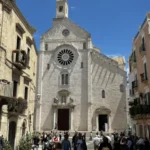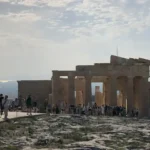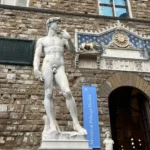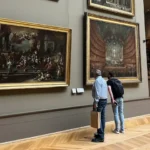The king of art museums, the Louvre in Paris, with its rich collection of the world’s most famous paintings, is a dream-come-true place for every art lover and traveler.
The facts are astonishing: the Louvre owns more than 380,000 objects and displays more than 35,000 works of art. That is quite… depressing, in the sense that you’ll probably never be able to enjoy the Louvre in its entirety. However, if you decide to visit, preparation is key. One of the most important things is not to miss the masterpieces (you’d be surprised how easy that is).
Here are the must-see, most valuable, and truly famous paintings at the Louvre that you definitely don’t want to miss:
1. Mona Lisa by Leonardo da Vinci, 1503–1519

Mona Lisa is definitely the most famous painting at the Louvre and in the world. If you get a chance to see it when there are fewer people around, you’re lucky. The painting is legendary because of Leonardo’s use of sfumato, a soft, smoky blending of tones, and the subject’s subtle, enigmatic expression that seems to shift depending on how you look at her. This expression has made the Mona Lisa a timeless symbol of artistic genius and human mystery.
In the same room, a little away from the painting, you might find an informative board prepared by the Louvre. It explains some details and reveals a little-known fact: Leonardo actually never finished the Mona Lisa. Try to get closer to see the details, if possible, as the painting is quite small and the distance between it and the observation point is surprisingly far.
Tips from Artsy Trips. Either before or after your visit, I recommend checking out this extraordinary painting online in the in the Louvre archives, where they provide the images of the painting in excellent quality and detail. The close-ups are especially impressive. You can also view the artwork without its frame, which is a rare opportunity.
This is not Leonardo’s only painting in the Louvre, so look around and don’t miss his other masterpieces. They are often easier to approach and explore in more detail. These include:
- The Virgin and Child with Saint Anne, 1503 / 1519 (actually, my favourite one from the works of da Vinci in the Louvre collection because of its fascinating atmospheric depth and dynamic yet harmonious composition)
- The Virgin, the Child Jesus, Saint John the Baptist and an angel, known as The Virgin of the Rocks, 1483 / 1494
- Saint John the Baptist, 1508 / 1519
Mona Lisa location: Room 711 (Salle des États), Denon wing, Level 1.
Other Leonardo paintings: Room 710 (Grand Gallery), Room Denon wing, Level 1.
Also, what should be added, is that The Louvre is incredible, but honestly? The lines are brutal — especially if you go during peak hours (which, let’s be real, is almost all the time). What saved me was booking a skip-the-line timed-entry ticket in advance.
2. Liberty Leading the People by Eugène Delacroix, 1830.

Liberty Leading the People (La Liberté guidant le peuple) is one of the most powerful and enduring images of revolution in Western art. Painted in 1830, the work was inspired by the July Revolution in Paris, during which the people rose up against the monarchy.
Interestingly, this masterpiece was finished the same year the event occurred (that is, 1830), showing the urgency and emotional intensity with which Delacroix captured the spirit of the revolution. Back then, it was believed that large-scale paintings should be reserved for grand historical or religious themes, but Delacroix broke with tradition, using that enormous canvas to portray a recent event that had unfolded only months earlier.
One might totally miss the point and the reason for its popularity if one sees it only as a historical painting. The work is actually a dramatic allegory of liberty, unity, and the will of the people, portrayed in the most passionate and emotionally charged Romantic aesthetics.
As SmartHistory wittily writes, “clearly, this monumental statue is not a portrait of a woman named Liberty who wears a Roman toga, carries a torch, and an inscribed tablet. Instead, she represents an idea. “ She represents both the ideal of freedom and the raw power of revolution. Surrounding her are men from different walks of life: a worker in a cap, a bourgeois gentleman in a top hat, and even a young boy brandishing pistols. This shows that liberty is a shared cause across social classes. It reminds us how important it is to stick together against tyranny and to keep liberty at the heart of everything we do.
Tips from Artsy Trips. Take your time to explore the small architectural detail on the right side of the painting. What you’ll see is a fragment of Notre-Dame, an architectural landmark of Paris. Look closely and try to find Delacroix’s signature hidden in the composition.
Delacroix’s masterful use of color and composition gives the painting a dynamic, almost cinematic movie-like energy. The smoke, movement, and emotion captured on the canvas plunge viewers into the chaos of the uprising. His brushwork, typical of the Romantic era, emphasizes passion and drama over precision, enhancing the raw emotional impact of the scene.
As one of the most emotionally charged works in the museum, it has earned its place among the most famous paintings at the Louvre, symbolizing the revolutionary spirit of France. You must stand in front of it to feel that energy still radiating from the canvas.
Location: Room 700 (Salle Mollien), Denon Wing, Level 1.
3. The Raft of the Medusa by Théodore Géricault, 1818 / 1819

The Raft of the Medusa (Le Radeau de la Méduse), painted by Théodore Géricault, stands out in the Louvre for its emotional intensity and haunting depiction of tragedy. You just need to give it a couple of minutes and allow yourself to be drawn into this massive canvas.
It portrays the horrifying aftermath of the real-life shipwreck of the French frigate Méduse. With no lifeboats available for the lower-class passengers, around 150 people were left to survive on a hastily built raft, where they had no choice but to resort to cannibalism to stay alive. Only 10 made it out alive.
The Raft of the Medusa is not only a historical painting; it’s also a monumental artistic achievement that marked a turning point in the evolution of modern art. Rather than idealizing the human form or presenting a heroic narrative, Géricault delivers a raw, unfiltered look at human suffering. He chose to depict the exact moment between despair and hope, as survivors spot a distant rescue ship on the horizon.
Artistically, Géricault broke with the strict academic traditions of his time. While trained in Neoclassicism, he embraced the Romantic movement’s emotional power, dramatic contrasts, and turbulent compositions. His figures are arranged in a dynamic pyramid structure, guiding the viewer’s eye upward from the twisted, dying bodies at the base to the desperate men signaling for help at the top. The striking contrast between light and dark (in art, this is known as the chiaroscuro effect) intensifies the painting’s dramatic tension. The stormy sea adds to the chaos, while the brutally realistic depiction of corpses and exhausted survivors hits the viewer with raw emotional force.
Géricault’s attention to detail was unmatched—he conducted anatomical studies at morgues, built a scale model of the raft, and even interviewed survivors to ensure authenticity.
Tips from Artsy Trips. Look at the lower center of the painting. Can you see a man lying face-down with his arm resting on a piece of wood? That figure was modeled by none other than Eugène Delacroix, another great artist of the Romantic era.
This painting brought social critique, emotional depth, and journalistic urgency into the world of fine art. Its influence can be seen in the works of artists like Delacroix and in modern painters who use art to address political and humanitarian issues. It remains one of the world’s most celebrated masterpieces, a defining symbol of Romanticism, and unquestionably one of the famous paintings at the Louvre.
Location: Room 700, Denon wing, Level 1
4. The Coronation of Napoleon by Jacques-Louis David, 1807

The Coronation of Napoleon by Jacques-Louis David is a breathtaking blend of political power and artistic mastery. When looking for this artwork in the Louvre, be prepared for something huge. This enormous canvas—over 6 meters high and nearly 10 meters wide—captures the moment in 1804 when Napoleon crowned himself Emperor in a lavish ceremony at Notre-Dame Cathedral, boldly breaking with tradition by placing the crown on his own head instead of receiving it from the Pope.
This painting is especially famous for its monumental scale and technical brilliance. David, Napoleon’s official painter and a master of Neoclassicism, composed the scene with over 100 finely rendered figures. Many of them, including Napoleon’s family members and key political figures, were painted from live sketches or sittings—though some were added later for political reasons. Notably, Napoleon’s mother is prominently seated in the painting, despite the fact that she did not attend the coronation at all— David included her to reinforce the idealized narrative Napoleon wanted to present to the public.
Every detail, from the rich velvet of Joséphine’s gown to the glimmering crown and scepter, is painted with extraordinary care. Some art historians call this painting a work of propaganda, designed to legitimize Napoleon’s rule and present him as both heroic and sovereign, above the monarchy and the church alike.
Due to its immense size, the painting was actually cut in half in 1889 to allow for its transportation to the Louvre, then meticulously rejoined and restored. Even today, its sheer scale and stunning detail make it one of the most unforgettable works on display.
Location: Room 702 (Salle Daru), Denon wing, Level 1
5. Madonna of Chancellor Rolin by Jan Van Eyck, 1400 / 1450

The Virgin and Child with Chancellor Rolin by Jan van Eyck from Belgium is one of the Louvre’s quiet masterpieces—small in size but rich in artistic and historical value. This work is a standout example of the Northern Renaissance, known for its precision, symbolism, and lifelike realism. With only a few of Van Eyck’s paintings surviving today, each one is a rare treasure. It is the only Van Eyck painting in the Louvre’s collection, and it continues to gain recognition and popularity, so do not miss the chance to see it.
Personally, it’s in my top three at the Louvre—but I admit, I’m a devoted admirer of Van Eyck’s mastery.
The scene shows Chancellor Nicolas Rolin kneeling in devotion before the Virgin Mary and Christ Child, set in a richly detailed architectural space. Van Eyck’s mastery of oil painting is on full display: from the shimmer of embroidered fabrics to the glowing cityscape in the background, every detail is rendered with incredible care. His use of layered glazes creates depth and luminosity that were groundbreaking for the time.
Some researchers believe Van Eyck may have used optical tools or early perspective devices to achieve such astonishing accuracy, though this remains a subject of debate. Regardless, his technical skill was revolutionary and shaped the future of realistic painting.
In 2024, the painting underwent a careful restoration and became the centerpiece of the Louvre’s exhibition “Revoir Van Eyck”. As Louvre writes, the layers of oxidised varnish that had darkened the paint were stripped away, restoring the work to its former glory. The show brought together his other works as well—an exceptional gathering in France—and invited visitors to explore his technique and legacy up close. I had the opportunity to visit this exclusive exhibition (after waiting in a looong queue), and I promise to write about it some other time.
Tips from Artsy Trips. After cleaning and restoration, new ultra-high-resolution images were created, allowing you to see every millimeter of the painting. Follow this link of the “Closer to Van Eyck” website to compare the artwork’s previous and current states, and dive into every particle of paint touched by Jan van Eyck’s brush. You won‘t regret.
Symbolism fills the composition: a walled garden suggests paradise, peacocks signify immortality, and two tiny figures on a balcony—possibly Van Eyck and an assistant—hint at the artist’s quiet presence. Rolin’s equal footing with the Virgin reflects the blend of sacred devotion and worldly power typical of the era.
Though less famous than some Louvre icons, this painting offers a rare kind of beauty—quiet, meticulous, and full of meaning—rewarding anyone who takes the time to find it in the Louvre and to truly look.
Location: Room 818, Richelieu Wing, Level 2.
The Louvre can be overwhelming, I won’t lie – it’s huge, it’s crowded, and it’s easy to wander past something incredible without even noticing. But if you have a little list in your pocket (or saved on your phone), everything changes. These famous paintings at the Louvre are the true heart of the museum. Each one has a story to tell, and trust me, they’re worth slowing down for.
Not everyone loves wandering alone — and as everyone knows, the Louvre is massive. If you’d rather have someone guide you through the highlights (and not miss a thing), here are three highly rated tours that include quick entry and expert commentary. I haven’t done any of these personally (yet!), but they’re all well-reviewed and offer different ways to explore the Louvre — whether you’re into classic highlights, small-group experiences, or deeper dives into the art. Definitely worth checking out if you want a more structured, stress-free visit.
You may also like





